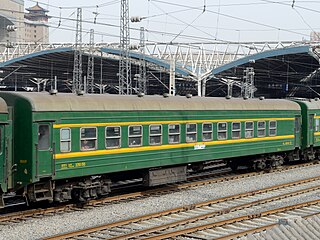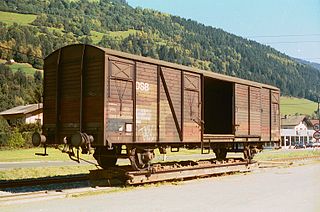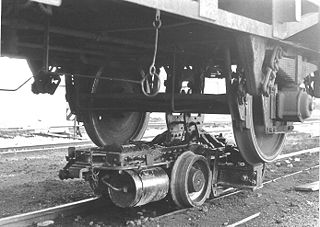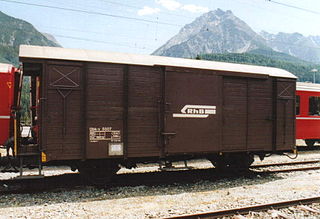
A railroad car, railcar, railway wagon, railway carriage, railway truck, railwagon, railcarriage or railtruck, also called a train car, train wagon, train carriage or train truck, is a vehicle used for the carrying of cargo or passengers on a rail transport network. Such cars, when coupled together and hauled by one or more locomotives, form a train. Alternatively, some passenger cars are self-propelled in which case they may be either single railcars or make up multiple units.

Intermodal freight transport involves the transportation of freight in an intermodal container or vehicle, using multiple modes of transportation, without any handling of the freight itself when changing modes. The method reduces cargo handling, and so improves security, reduces damage and loss, and allows freight to be transported faster. Reduced costs over road trucking is the key benefit for inter-continental use. This may be offset by reduced timings for road transport over shorter distances.

A loading gauge is a diagram or physical structure that defines the maximum height and width dimensions in railway vehicles and their loads. Their purpose is to ensure that rail vehicles can pass safely through tunnels and under bridges, and keep clear of platforms, trackside buildings and structures. Classification systems vary between different countries, and gauges may vary across a network, even if the track gauge is uniform.

The International Union of Railways is an international rail transport industry body.

A transporter wagon, in railway terminology, is a wagon (UIC) or railroad car (US) designed to carry other railway equipment. Normally, it is used to transport equipment of a different rail gauge. In most cases, a transporter wagon is a narrower gauge wagon for transporting a wider gauge equipment, allowing freight in a wider gauge wagons to reach destinations on the narrower gauge network without the expense and time of transshipment into a narrower gauge wagons.

A flatcar (US) is a piece of rolling stock that consists of an open, flat deck mounted on a pair of trucks (US) or bogies (UK), one at each end containing four or six wheels. Occasionally, flat cars designed to carry extra heavy or extra large loads are mounted on a pair of bogies under each end. The deck of the car can be wood or steel, and the sides of the deck can include pockets for stakes or tie-down points to secure loads. Flatcars designed for carrying machinery have sliding chain assemblies recessed in the deck.

Rail freight transport is the use of railways and trains to transport cargo as opposed to human passengers.

Rollbocks, sometimes called transporter trailers, are narrow gauge railway trucks or bogies that allow a standard gauge wagon to 'piggyback' on a narrow-gauge line. The Vevey system enables a coupled train of standard gauge wagons to be automatically loaded or rolled onto Rollbocks, so that the train can then continue through a change of gauge.

A well car, also known as a double-stack car, is a type of railroad car specially designed to carry intermodal containers used in intermodal freight transport. The "well" is a depressed section that sits close to the rails between the wheel trucks of the car, allowing a container to be carried lower than on a traditional flatcar. This makes it possible to carry a stack of two containers per unit on railway lines wherever the structure gauge assures sufficient clearance. The top container is secured to the bottom container either by a bulkhead built into the car — possible when bottom and top containers are the same dimensions, or through the use of inter-box connectors (IBC). Four IBCs are needed per well car. In the terminal there are four steps: unlock and lift off the top containers of an inbound train, remove the bottom containers, insert outbound bottom containers, lock assembly after top containers emplaced. Generally this is done car-by-car unless multiple crane apparatus are employed.

In rail transportation, a rolling highway or rolling road is a form of combined transport involving the conveying of road trucks by rail, referred to as Ro-La trains. The concept is a form of piggyback transportation.

Goods wagons or freight wagons, also known as goods carriages, goods trucks, freight carriages or freight trucks, are unpowered railway vehicles that are used for the transportation of cargo. A variety of wagon types are in use to handle different types of goods, but all goods wagons in a regional network typically have standardized couplers and other fittings, such as hoses for air brakes, allowing different wagon types to be assembled into trains. For tracking and identification purposes, goods wagons are generally assigned a unique identifier, typically a UIC wagon number, or in North America, a company reporting mark plus a company specific serial number.

Open wagons form a large group of railway goods wagons designed primarily for the transportation of bulk goods that are not moisture-retentive and can usually be tipped, dumped or shovelled. The International Union of Railways (UIC) distinguishes between ordinary wagons and special wagons (F/6). Open wagons often form a significant part of a railway company's goods wagon fleet; for example, forming just under 40% of the Deutsche Bahn's total goods wagon stock in Germany.

Flat wagons, as classified by the International Union of Railways (UIC), are railway goods wagons that have a flat, usually full-length, deck and little or no superstructure. By contrast, open wagons have high side and end walls and covered goods wagons have a fixed roof and sides. Flat wagons are often designed for the transportation of goods that are not weather-sensitive. Some flat wagons are able to be covered completely by tarpaulins or hoods and are therefore suitable for the transport of weather-sensitive goods. Unlike a "goods wagon with opening roof", the loading area of a flat is entirely open and accessible once the cover is removed.

A covered goods wagon or covered goods van is a railway goods wagon which is designed for the transportation of moisture-susceptible goods and therefore fully enclosed by sides and a fixed roof. They are often referred to simply as covered wagons, and this is the term used by the International Union of Railways (UIC). Since the introduction of the international classification for goods wagons by the UIC in the 1960s a distinction has been drawn between ordinary and special covered wagons. Other types of wagon, such as refrigerated vans and goods wagons with opening roofs, are closely related to covered wagons from a design point of view. Similar freight cars in North America are called boxcars.
The International Union of Railways groups all special classes of railway goods wagon into Class U in its goods wagon classification system.

Tiphook PLC was a United Kingdom headquartered transport services company that was registered on both the London and New York stock markets. It was once a constituent of the FTSE 100 Index and became the world's second largest marine container leasing business in the 1990s.

Double-stack rail transport is a form of intermodal freight transport in which railroad cars carry two layers of intermodal containers. Invented in the United States in 1984, it is now being used for nearly seventy percent of United States intermodal shipments. Using double stack technology, a freight train of a given length can carry roughly twice as many containers, sharply reducing transport costs per container. On United States railroads special well cars are used for double-stack shipment to reduce the needed vertical clearance and to lower the center of gravity of a loaded car. In addition, the well car design reduces damage in transit and provides greater cargo security by cradling the lower containers so their doors cannot be opened. A succession of larger container sizes have been introduced to further increase shipping productivity in the United States.

A bogie bolster wagon is a British railway term for a wagon designed to carry long thin cargoes such as timber or rails and other steel sections. The sides and ends are minimal and there is no roof. The load is carried longitudinally and borne by three or more bolsters fixed transversely. The load is constrained sideways by movable metal stanchions fitted into the ends of the bolsters, and secured with chains and shackles.
The Victorian Railways used a variety of flat wagons for the transport of a wide range of loads. Generally speaking, the bogie wagons were custom-built for the job, while the fixed-wheel variants were cut down from former open wagons. Loadings would be placed on the deck and, if necessary, protected with tarps, then secured to the wagons with chains or rope connecting to lashing rings along the side of the wagon frames.

The kangourou wagon is a type of rail wagon designed for the transport of semi-trailers. It has a drawbridge forming a pocket in the low position allowing the carrier train of the semi-trailer to be placed and thus to respect the height of the loading gauge.























